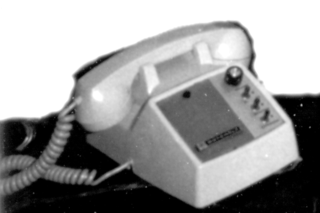
A telephone is a telecommunications device that permits two or more users to conduct a conversation when they are too far apart to be heard directly. A telephone converts sound, typically and most efficiently the human voice, into electronic signals that are transmitted via cables and other communication channels to another telephone which reproduces the sound to the receiving user. The term is derived from Greek: τῆλε and φωνή, together meaning distant voice. A common short form of the term is phone, which came into use almost immediately after the first patent was issued.
In telecommunications, a voice operated switch, also known as VOX or voice-operated exchange, is a switch that operates when sound over a certain threshold is detected. It is usually used to turn on a transmitter or recorder when someone speaks and turn it off when they stop speaking. It is used instead of a push-to-talk button on transmitters or to save storage space on recording devices. On cell phones, it is used to save battery life. Intercom systems that use a speaker in a room as both a speaker and a microphone will often use VOX on the main console to switch the audio direction during a conversation. The circuit usually includes a delay between the sound stopping and switching direction, to avoid the circuit turning off during short pauses in speech.

A fence is a structure that encloses an area, typically outdoors, and is usually constructed from posts that are connected by boards, wire, rails or netting. A fence differs from a wall in not having a solid foundation along its whole length.
Eh is a spoken interjection used in many varieties of English that is similar in meaning to "Excuse me?," "Please repeat that", or "Huh?". It is also commonly used as an alternative to the question tag right?, i.e., method for inciting a reply, as in "It's nice here, eh?". In North America, it is most commonly associated with Canada and Canadian English, and the area stretching from northern Wisconsin up to Michigan's Upper Peninsula. Similar interjections exist in other languages, such as Dutch, Azerbaijani, Armenian, Hokkien Chinese, Japanese, French, Finnish, Italian, German, Greek, Hebrew, Malay, Malaysian English, Singapore English, Spanish, Persian, Portuguese, Arabic, Turkish, Swahili, Korean, Catalan and Filipino.

Metonymy is a figure of speech in which a thing or concept is referred to by the name of something closely associated with that thing or concept.

A radiotelephone is a radio communication system for transmission of speech over radio. Radiotelephony means transmission of sound (audio) by radio, in contrast to radiotelegraphy, which is transmission of telegraph signals, or television, transmission of moving pictures and sound. The term may include radio broadcasting systems, which transmit audio one way to listeners, but usually refers to two-way radio systems for bidirectional person-to-person voice communication between separated users, such as CB radio or marine radio. In spite of the name, radiotelephony systems are not necessarily connected to or have anything to do with the telephone network, and in some radio services, including GMRS, interconnection is prohibited.

A two-way radio is a radio that can both transmit and receive radio waves, unlike a broadcast receiver which only receives content. It is an audio (sound) transceiver, a transmitter and receiver in one unit, used for bidirectional person-to-person voice communication with other users with similar radios. Two-way radios are available in stationary, mobile, and hand-held portable models. Hand-held two-way radios are often called walkie-talkies, handie-talkies or hand-helds. Two-way radios are used by groups of geographically separated people who need to keep in continuous voice communication, such as aircraft pilots and air traffic controllers, ship captains and harbormasters, emergency services personnel like firemen, policemen, and ambulance paramedics, taxi and delivery services, soldiers and military units, fast food and warehouse employees, and radio amateurs.
In the United States, a heckler's veto is a situation in which a party who disagrees with a speaker's message is able to unilaterally trigger events that result in the speaker being silenced.
In social science generally and linguistics specifically, the cooperative principle describes how people achieve effective conversational communication in common social situations—that is, how listeners and speakers act cooperatively and mutually accept one another to be understood in a particular way. As phrased by Paul Grice, who introduced it in his pragmatic theory,
Make your contribution such as is required, at the stage at which it occurs, by the accepted purpose or direction of the talk exchange in which you are engaged.
"Pardon my French" or "Excuse my French" is a common English language phrase ostensibly disguising profanity as words from the French language. The phrase is uttered in an attempt to excuse the user of profanity, swearing, or curses in the presence of those offended by it, under the pretense of the words being part of a foreign language. Although the phrase is often used without any explicit or implicit intention of insulting the French people or language, it can nevertheless be perceived as offensive and belittling by Francophone speakers. However, most users of the term intend no such belittlement, but rather a light-hearted way of apologizing on-the-fly for having used a somewhat profane comment. In other words, it can be used as a very effective oral English device to indicate that the speaker does not intend to escalate the general level of profanity use.

Picket fences are a type of fence often used decoratively for domestic boundaries, distinguished by their evenly-spaced vertical boards, the pickets, attached to horizontal rails. Picket fences are particularly popular in the United States, with white picket fences symbolising the suburban middle class.

A chain-link fence is a type of woven fence usually made from galvanized or LLDPE-coated steel wire. The wires run vertically and are bent into a zig-zag pattern so that each "zig" hooks with the wire immediately on one side and each "zag" with the wire immediately on the other. This forms the characteristic diamond pattern seen in this type of fence.
This is a comparison of standards of mobile phones. A new generation of cellular standards has appeared approximately every tenth year since 1G systems were introduced in 1979 and the early to mid-1980s.
Herbert Herb Clark is a psycholinguist currently serving as Professor of Psychology at Stanford University. His focuses include cognitive and social processes in language use; interactive processes in conversation, from low-level disfluencies through acts of speaking and understanding to the emergence of discourse; and word meaning and word use. Clark is known for his theory of "common ground": individuals engaged in conversation must share knowledge in order to be understood and have a meaningful conversation. Together with Deanna Wilkes-Gibbs (1986), he also developed the collaborative model, a theory for explaining how people in conversation coordinate with one another to determine definite references. Clark's books include Semantics and Comprehension, Psychology and Language: An Introduction to Psycholinguistics, Arenas of Language Use and Using Language.

A steel fence post, also called a T-post, a Y-post, or variants on star post, is a type of fence post or picket. They are made of steel and are sometimes manufactured using durable rail steel. They can be used to support various types of wire or wire mesh. The end view of the post creates an obvious T, Y, or other shape. The posts are driven into the ground with a manual or pneumatic post pounder. All along the post, along the spine, there are studs or nubs that prevent the barbed wire or mesh from sliding up or down the post. They are generally designated as 1.01, 1.25 or 1.33, referring to the weight in pounds per lineal foot. They are commonly painted with a white tip on top; white improves the visibility of the fence line.

Remote controls are used any time a two-way radio base station is located away from the desk or office where communication originates. For example, a dispatch center for taxicabs may have an office downtown but have a base station on a distant mountain top. A Tone remote, also known as an EIA Tone remote, is a signaling system used to operate a two-way radio base station by some form of remote control.

Speech-generating devices (SGDs), also known as voice output communication aids, are electronic augmentative and alternative communication (AAC) systems used to supplement or replace speech or writing for individuals with severe speech impairments, enabling them to verbally communicate. SGDs are important for people who have limited means of interacting verbally, as they allow individuals to become active participants in communication interactions. They are particularly helpful for patients suffering from amyotrophic lateral sclerosis (ALS) but recently have been used for children with predicted speech deficiencies.
Christianese refers to the contained terms and jargon used within many of the branches and denominations of Christianity as a functional system of religious terminology. It is characterized by the use in everyday conversation of certain words, theological terms, puns and catchphrases, in ways that may be only comprehensible within the context of a particular Christian sect or denomination. The terms used do not necessarily come from the Bible itself. They may have come into use through discussions about doctrine, through the social history of the Christian church at large, or in the unique history of a specific denomination or movement.
Picket fence is a type of wooden fence.
In linguistics, a co-construction is a single syntactic entity in conversation and discourse that is uttered by more than two or more speakers. Other names for this concept include collaboratively built sentences, sentences-in-progress, and joint utterance constructions. Used in this specific linguistic context, co-construction is not to be confused with the broader social interactional sense of the same name. Co-construction is studied across several linguistic sub-disciplines, including applied linguistics, conversation analysis, linguistic anthropology, and language acquisition.









